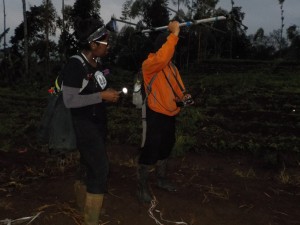Since getting to the West Java I have been working with the wonderful LFP team to measure mental map use in slow lorises. While this may seem like a difficult thing to measure, it is great fun to do and we have a poor understanding of slow loris spatial cognition. Having followed the Javan slow lorises here for the past 3+ years we have learned so much about their feeding, sleeping, and social habits. This knowledge has made it easy for me to find resources and locations that individual lorises will frequent each night. Using these locations I can map their route and determine if they are efficiently traveling through the agroforest they live in, perhaps by means of their mental map of the area?!?
One of my favorite and by far the cutest revisited location is a parked infant. A few of our focal lorises have been seen with an extra set of tiny red eyes with them. Slow lorises are among the animals who park their babies while they leave to secure needed resources. For my research this was a clear choice for revisited locations, and who wouldn’t want to sit and wait by baby lorises.
 By taking GPS points every 15 minutes as we track the mother’s movements through the forest, I can later map out her route back to those little red eyes, which are waiting in a nearby tree. During our 6-hour observation shifts, I have noticed that mothers frequently return to their babies between bouts of catching insects and gouging the local gum trees.
By taking GPS points every 15 minutes as we track the mother’s movements through the forest, I can later map out her route back to those little red eyes, which are waiting in a nearby tree. During our 6-hour observation shifts, I have noticed that mothers frequently return to their babies between bouts of catching insects and gouging the local gum trees.
To get a sense of how the males and females without babies navigate the forest, I have also followed individuals to their favorite gum tree (Jiengjen) especially now during the dry season. When consuming gum, lorises must first gouge sizable holes into the trunk and branches of a tree, and in time the tree produces a gum to repair these holes. Slow lorises love to eat this gum, making these trees yet another great option as a revisited location.
Once I have recorded as many slow loris routes as possible, I will look at each one to determine how long and how efficiently individuals travel to a specific point. Though I am still just collecting data, I get the impression that slow lorises do in fact have a plan and know just where they are and where they are going. I’ll have to wait to see what the data tells me in the end, but I am excited to learn more about slow loris spatial cognition and even more excited to share what I find.
– Stephanie Poindexter, PhD student
